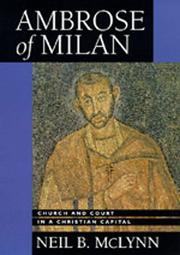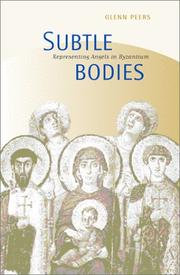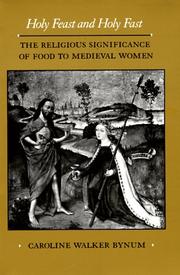| Listing 1 - 4 of 4 |
Sort by
|
Book
ISBN: 9781526100276 9781526100269 9781526109675 1526109670 1526100266 1526100274 9780719095962 0719095964 Year: 2016 Publisher: Manchester
Abstract | Keywords | Export | Availability | Bookmark
 Loading...
Loading...Choose an application
- Reference Manager
- EndNote
- RefWorks (Direct export to RefWorks)
A study of the 'Scottish Legendary' of the late 14th century. The only extant collection of saints' lives in the vernacular from medieval Scotland, the work scrutinises the dynamics of hagiographic narration, its implicit assumptions about literariness, and the functions of telling the lives of the saints.
Scottish literature --- English literature --- Scottish poetry --- Saints in literature. --- Religion in literature. --- Christian hagiography in literature. --- History and criticism. --- Scottish authors --- Religion in drama --- Religion in poetry --- Scots literature --- British literature --- Littérature écossaise --- Littérature anglaise --- Poésie écossaise --- Saints dans la littérature --- Religion dans la littérature --- Hagiographie chrétienne dans la littérature --- Histoire et critique --- Auteurs écossais --- History and criticism --- To 1700 --- Hagiography. --- Narrative art. --- Narrative theory. --- Saints' lives. --- Scotland.

ISBN: 0520914554 0585139784 9780520914551 9780585139784 0520084616 9780520084612 Year: 1994 Publisher: Berkeley
Abstract | Keywords | Export | Availability | Bookmark
 Loading...
Loading...Choose an application
- Reference Manager
- EndNote
- RefWorks (Direct export to RefWorks)
In this new and illuminating interpretation of Ambrose, bishop of Milan from 374 to 397, Neil McLynn thoroughly sifts the evidence surrounding this very difficult personality. The result is a richly detailed interpretation of Ambrose's actions and writings that penetrates the bishop's painstaking presentation of self. McLynn succeeds in revealing Ambrose's manipulation of events without making him too Machiavellian. Having synthesized the vast complex of scholarship available on the late fourth century, McLynn also presents an impressive study of the politics and history of the Christian church and the Roman Empire in that period.Admirably and logically organized, the book traces the chronology of Ambrose's public activity and reconstructs important events in the fourth century. McLynn's zesty, lucid prose gives the reader a clear understanding of the complexities of Ambrose's life and career and of late Roman government.
Church and state --- Church history --- Apostolic Church --- Christianity --- Church, Apostolic --- Early Christianity --- Early church --- Primitive and early church --- Primitive Christianity --- Fathers of the church --- Great Apostasy (Mormon doctrine) --- Christianity and state --- Separation of church and state --- State and church --- State, The --- Ambrose, --- Ambrogio, --- Ambroise, --- Ambrosio, --- Ambrosius Mediolanensis, --- Ambrosius, --- Ambrosius von Mailand, --- Amvrosīĭ, --- Aurelio Ambrogio, --- Aurelius Ambrosius, --- Rome --- History --- Ambrogio --- Ambroise --- Ambrose --- Ambrosio --- Ambrosius Mediolanensis --- Ambrosius --- Ambrosius von Mailand --- Amvrosīĭ --- Aurelio Ambrogio --- Aurelius Ambrosius --- ambrose. --- auxentius. --- bishop of milan. --- bishop. --- catholic church. --- christian church. --- christian pliny. --- church doctrine. --- church history. --- church leaders. --- church politics. --- constantius. --- council of 355. --- council of aquileia. --- de fide. --- de spiritu sancto. --- easter crisis 386. --- exegesis. --- gratian. --- martyrs. --- palladius. --- penance. --- religion. --- religious leaders. --- rhetoric. --- roman emperors. --- roman empire. --- roman government. --- saint ambrose. --- saints lives. --- saints. --- sanctification. --- satyrus. --- theodosius. --- valentinian ii. --- western christianity.

ISBN: 9786612356308 0520925130 1282356305 1597349240 9780520925137 1417523840 9781417523849 9780520224056 0520224051 9781597349246 6612356308 0520224051 9781282356306 Year: 2001 Publisher: Berkeley University of California Press
Abstract | Keywords | Export | Availability | Bookmark
 Loading...
Loading...Choose an application
- Reference Manager
- EndNote
- RefWorks (Direct export to RefWorks)
Throughout the course of Byzantine history, Christian doctrine taught that angels have a powerful place in cosmology. It also taught that angels were immaterial, bodiless, invisible beings. But if that were the case, how could they be visualized and depicted in icons and other works of art? This book describes the strategies used by Byzantine artists to represent the incorporeal forms of angels and the rationalizations in defense of their representations mustered by theologians in the face of iconoclastic opposition. Glenn Peers demonstrates that these problems of representation provide a unique window on Late Antique thought in general.
Church history --- Angels in literature. --- Angels in art. --- Angels --- Iconoclasm --- Christianity --- Angels (Buddhism) in art --- Idols and images --- Biblical teaching. --- History. --- Middle Ages, 600-1500 --- History --- Worship --- Orthodox Eastern Church --- Byzantine Empire --- Church history. --- Orthodox Eastern Church -- Byzantine Empire -- History.. --- Iconoclasm -- Byzantine Empire -- History.. --- Angels -- Biblical teaching.. --- Angels in art.. --- Angels in literature.. --- Church history -- Middle Ages, 600-1500.. --- Byzantine Empire -- Church history. --- aesthetics. --- ancient world. --- angels in art. --- angels in literature. --- angels. --- archangel. --- art. --- barberini diptych. --- bible. --- bodies. --- byzantine art. --- byzantium. --- cherub. --- cherubim. --- church doctrine. --- divinity. --- early christian theology. --- early church. --- embodiment. --- folk belief. --- folk religion. --- greece. --- hagiography. --- hellenism. --- iconoclasm. --- icons. --- literature. --- madonna. --- magritte. --- michael. --- middle ages. --- religion. --- religious practices. --- saints legends. --- saints lives. --- saints. --- sarcophagus. --- theology. --- unrepresentable. --- virgin and child.

ISBN: 0520057228 0520063295 128007891X 9786613520180 0520908783 0585326487 9780520908789 9780585326481 9780520057227 9780520063297 9781280078910 6613520187 Year: 1988 Volume: vol 1 Publisher: Berkeley University of California press
Abstract | Keywords | Export | Availability | Bookmark
 Loading...
Loading...Choose an application
- Reference Manager
- EndNote
- RefWorks (Direct export to RefWorks)
In the period between 1200 and 1500 in western Europe, a number of religious women gained widespread veneration and even canonization as saints for their extraordinary devotion to the Christian eucharist, supernatural multiplications of food and drink, and miracles of bodily manipulation, including stigmata and inedia (living without eating). The occurrence of such phenomena sheds much light on the nature of medieval society and medieval religion. It also forms a chapter in the history of women. Previous scholars have occasionally noted the various phenomena in isolation from each other and have sometimes applied modern medical or psychological theories to them. Using materials based on saints' lives and the religious and mystical writings of medieval women and men, Caroline Walker Bynum uncovers the pattern lying behind these aspects of women's religiosity and behind the fascination men and women felt for such miracles and devotional practices. She argues that food lies at the heart of much of women's piety. Women renounced ordinary food through fasting in order to prepare for receiving extraordinary food in the eucharist. They also offered themselves as food in miracles of feeding and bodily manipulation. Providing both functionalist and phenomenological explanations, Bynum explores the ways in which food practices enabled women to exert control within the family and to define their religious vocations. She also describes what women meant by seeing their own bodies and God's body as food and what men meant when they too associated women with food and flesh. The author's interpretation of women's piety offers a new view of the nature of medieval asceticism and, drawing upon both anthropology and feminist theory, she illuminates the distinctive features of women's use of symbols. Rejecting presentist interpretations of women as exploited or masochistic, she shows the power and creativity of women's writing and women's lives.
Food --- Women --- Food habits --- Aliments --- Femmes --- Habitudes alimentaires --- Religious aspects --- Christianity --- History --- Aspect religieux --- Christianisme --- Histoire --- Social history --- Eglise catholique --- History of doctrines --- 248.153.4 --- 396 "04/14" --- -Social history --- -Food --- -Food habits --- -Eating --- Food customs --- Foodways --- Human beings --- Habit --- Manners and customs --- Diet --- Nutrition --- Oral habits --- Foods --- Dinners and dining --- Home economics --- Table --- Cooking --- Dietaries --- Gastronomy --- Descriptive sociology --- Social conditions --- Sociology --- Human females --- Wimmin --- Woman --- Womon --- Womyn --- Females --- Femininity --- Vasten. Versterving. Onthouding --- Feminisme. Vrouwenbeweging. Vrouw en maatschappij--Middeleeuwen --- -Religious aspects --- -Christianity --- -History of doctrines --- -History --- -Vasten. Versterving. Onthouding --- 396 "04/14" Feminisme. Vrouwenbeweging. Vrouw en maatschappij--Middeleeuwen --- 248.153.4 Vasten. Versterving. Onthouding --- Christianity. --- -248.153.4 Vasten. Versterving. Onthouding --- Eating --- History of civilization --- Christian spirituality --- anno 1200-1499 --- Middle Ages, 500-1500 --- Primitive societies --- Food - Religious aspects - Christianity --- Women - History - Middle Ages, 500-1500 --- Food habits - History --- Aliments - Aspect religieux - Eglise catholique --- Femmes - Histoire - 500-1500 (Moyen Age) --- Habitudes alimentaires - Histoire --- Food - Religious aspects - Christianity - History of doctrines - Middle Ages, 600-1500 --- Social history - Medieval, 500-1500 --- Food habits - History - To 1500 --- anthropology. --- catholicism. --- devotional practices. --- eucharist. --- fasting. --- feminism. --- feminist theory. --- food studies. --- food. --- gender studies. --- gender. --- historiography. --- history. --- inedia. --- medieval asceticism. --- medieval religion. --- medieval society. --- medieval women. --- middle ages. --- miracles. --- mysticism. --- nonfiction. --- piety. --- religion. --- religiosity. --- religious studies. --- religious vocation. --- religious women. --- renunciation. --- saints lives. --- saints. --- stigmata. --- symbolism. --- western europe. --- women and religion. --- womens lives. --- womens studies. --- womens writing. --- world history. --- MEDIEVAL CIVILIZATION --- WOMEN --- HABITUDES ALIMENTAIRES --- HISTORY --- MIDDLE AGES, 500-1500 --- MOYEN AGE
| Listing 1 - 4 of 4 |
Sort by
|

 Search
Search Feedback
Feedback About UniCat
About UniCat  Help
Help News
News